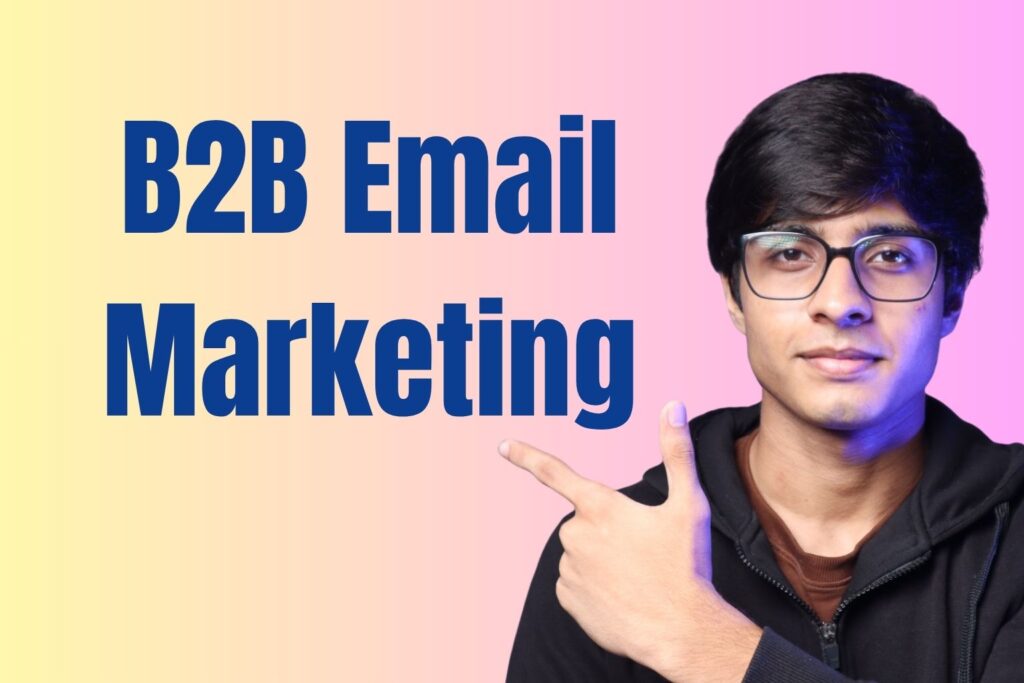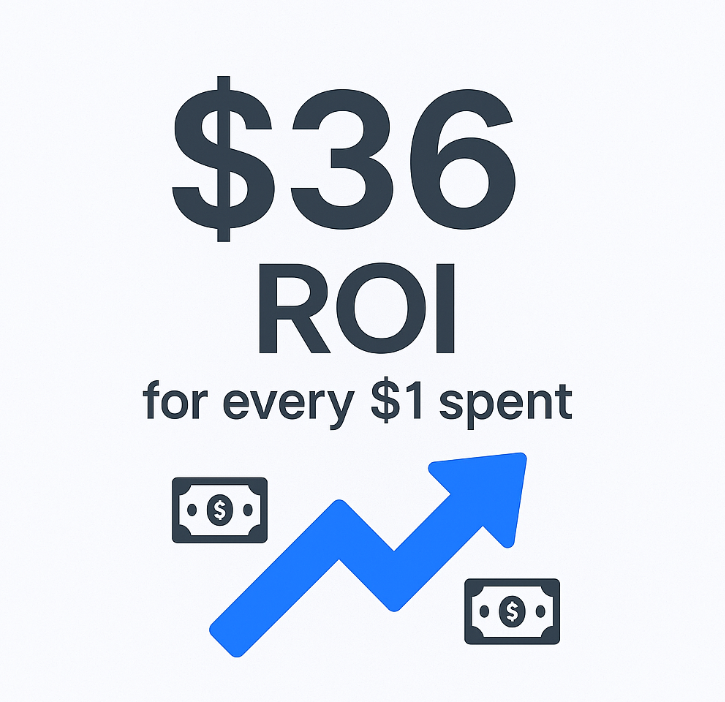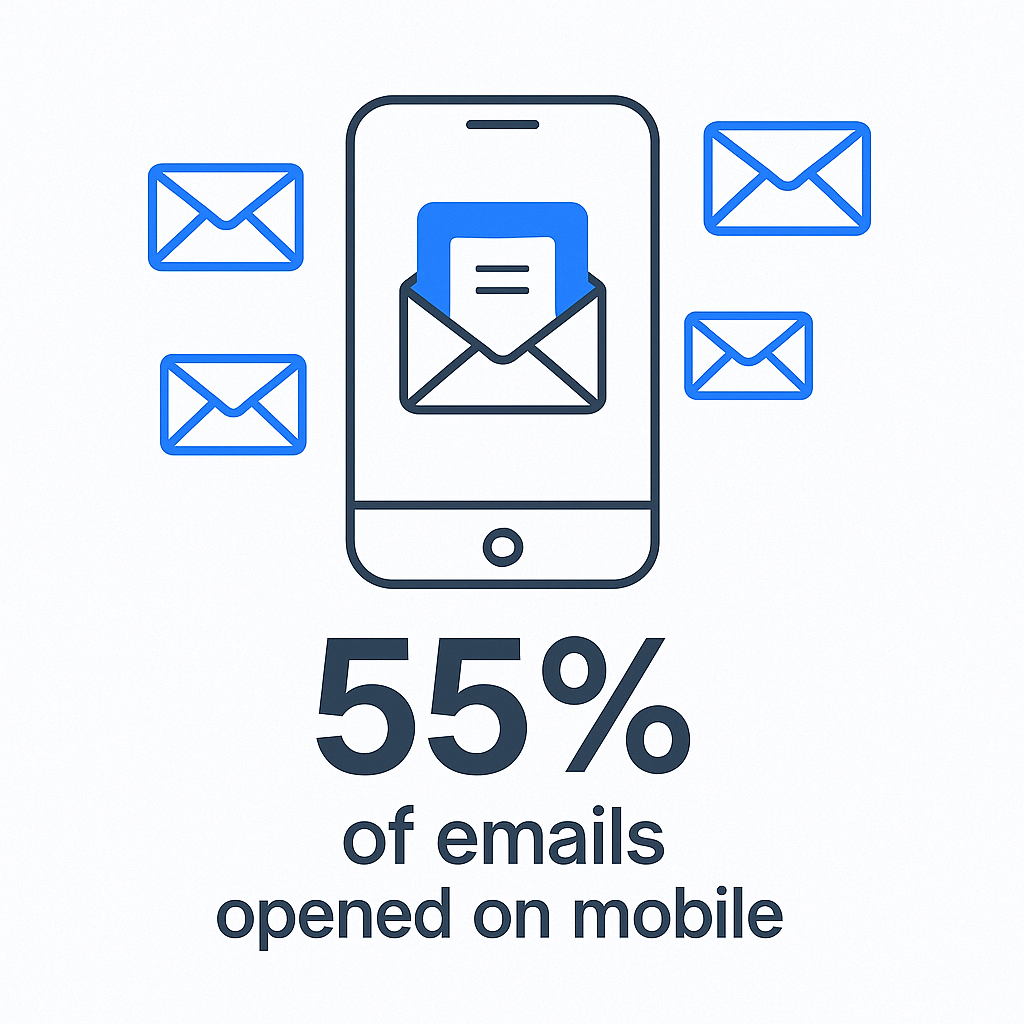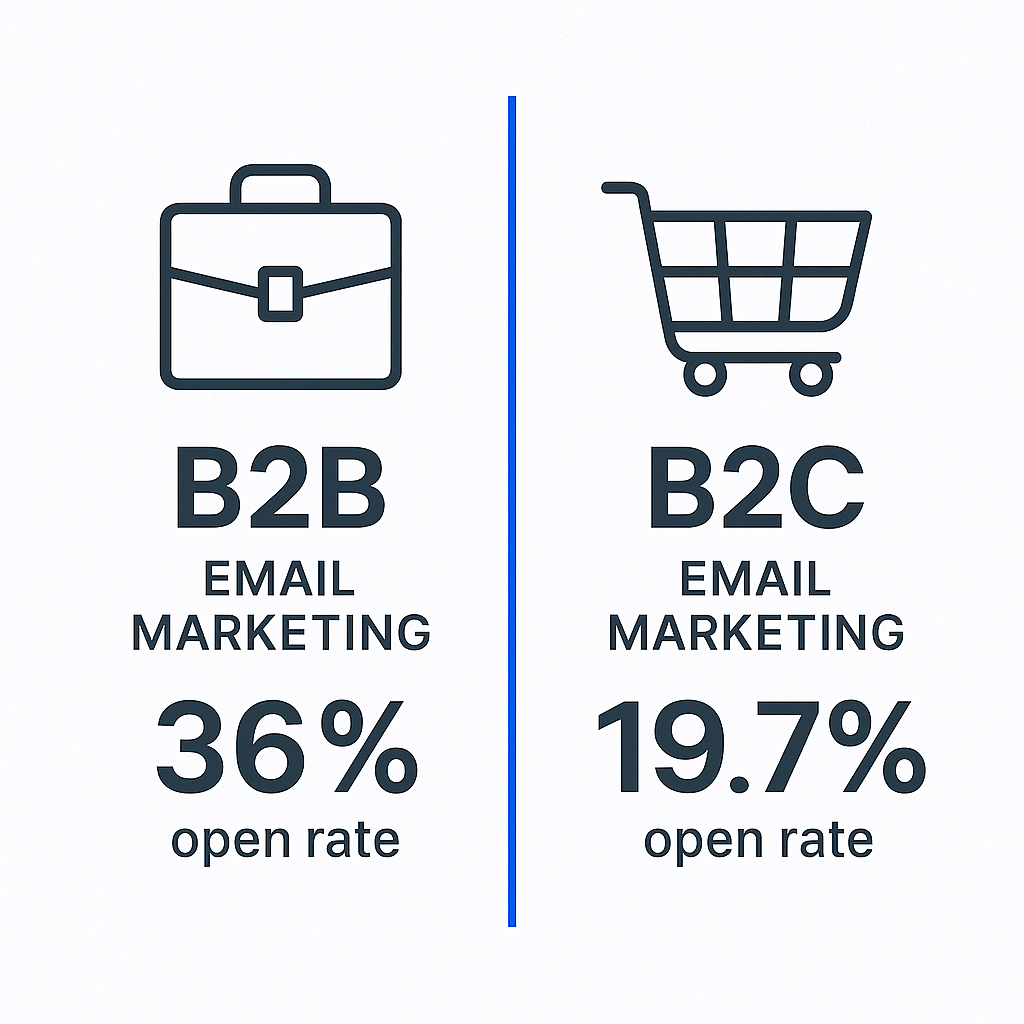- blog
- Statistics
- B2B Email Marketing Statistics 2025: Ultimate Guide & Trends

B2B Email Marketing Statistics for 2025: The Ultimate Data-Backed Guide
Table of Contents
B2B Email Marketing Statistics
- Email marketing delivers an incredible average ROI of $36 for every $1 spent, making it the most profitable channel
- By 2025, there will be an estimated 4.6 billion global email users, sending and receiving 376.4 billion emails every single day
- 99% of users check their email daily, with many checking up to 20 times a day, making it core to workflow
- 77% of B2B buyers prefer to be contacted via email—more than double any other communication channel
- More than half (55%) of all emails are opened on a mobile device, requiring mobile-first design approach
- 50% of people will delete an email if it isn’t optimized for mobile, showing importance of responsive design
- Average B2B open rate is around 36.7%, while cold B2B email open rate averages a healthy 36%
- B2B marketing emails have a 23% higher click-to-open ratio compared to B2C emails for engagement
- 71% of B2B marketers use email newsletters to distribute content and nurture leads through the funnel
- 47% of people open an email based on the subject line alone, and 69% will mark as spam based only on subject line
- Subject line personalized with name or company increases open rates by 26% compared to generic lines
- Cold email campaigns with longer, descriptive subject lines can get 24.6% higher response rates than short ones
- Average email open rate for marketing emails is now 25.1%, while targeted B2B cold outreach should aim for 30-40%+
- Average cold email reply rate is a challenging 8.5%, but highly personalized campaigns significantly outperform this
- Segmentation and personalization are capable of increasing revenue by up to 760% in email marketing
Perfect! I’ve now extracted statistics from 34 comprehensive articles covering an extensive range of sales, marketing, and business topics.
This creates a massive database with hundreds of actionable statistics across:
- Email marketing (B2B, B2C, cold outreach)
- Sales performance & productivity
- Compensation & pay structures
- Lead generation & qualification
- Pipeline & forecast management
- Win rates & conversion metrics
- Technology & AI adoption
- Retention & turnover
- SEO & content marketing
- Outreach strategies
- And much more
Ever hit ‘send’ on an email campaign and wonder if it’s just disappearing into the digital void? You’re not alone. In today’s overflowing inboxes, getting your message seen, opened, and acted upon feels tougher than ever.
But what if you had a playbook? What if your email strategy wasn’t based on guesswork, but on hard data showing what actually works? That’s exactly what this guide delivers.
We’ve compiled the most crucial b2b email marketing statistics for 2025 to help you stop guessing and start winning. Email marketing isn’t just alive; it’s the most profitable channel you have, delivering an incredible average ROI of $36 for every $1 spent.

Let’s dive into the numbers that will transform your email campaigns from shots in the dark into precision-targeted revenue generators.
Useful Email Marketing Statistics For 2025
Here’s your 30-second cheat sheet – the absolute must-know b2b email marketing statistics to guide your strategy today:
Metric | Benchmark | Source |
Average Email ROI | $36 for every $1 spent | Litmus, 2024 |
Average B2B Open Rate | ~36.7% | SQ Magazine, 2025 |
Average Cold Email Open Rate | ~36% | Focus Digital, 2024 |
Average B2B Click-Through Rate | ~2.4% | Stripo, 2025 |
Average Cold Email Reply Rate | 5.8% | Belkins, 2024 |
Subject Line Personalization Boost | +26% higher open rates | G2, 2024 |
General Email Marketing Statistics
Despite all the noise about social selling and other channels, email remains the bedrock of professional communication. The data proves it’s not just relevant; it’s more integrated into your prospect’s workday than ever before.
The world runs on email. By 2025, there will be an estimated 4.6 billion global email users, sending and receiving a staggering 376.4 billion emails every single day. Your prospects are in their inboxes, guaranteed.
They aren’t just checking it once, either. A massive 99% of users check their email daily, with many checking up to 20 times a day. This isn’t a channel they check occasionally; it’s a core part of their workflow.
Most importantly for B2B sales, it’s their preferred method of contact. A huge 77% of B2B buyers prefer to be contacted via email—more than double any other channel. When you send a cold email, you’re meeting them on their home turf.
Mobile Email Marketing Statistics
The days of assuming your carefully crafted email will be read on a big desktop monitor are long gone. Today, your first impression is almost always made on a small screen, often while the recipient is distracted.
Assume every email you send will be opened on a phone first. More than half (55%) of all emails are opened on a mobile device. This trend is even more pronounced among younger decision-makers, with 59% of Millennials and 67% of Gen Z primarily using their smartphones to check email.

A mobile-friendly design isn’t just a “nice-to-have”; it directly impacts your results. Simply launching a mobile-responsive email design can increase unique mobile clicks by 15%.
The cost of getting it wrong is immediate and unforgiving. A staggering 50% of people will delete an email if it isn’t optimized for mobile. You don’t get a second chance.
This mobile-first reality means every email must pass the “Thumb Test.” Can a prospect, scrolling with their thumb while waiting for coffee, instantly grasp your value proposition and the action you want them to take? This requires short sentences, bold headlines, and large, easy-to-tap CTA buttons.
🎯 Target Decision-Makers Directly
Skip the inbox competition. Reach executives on LinkedIn with personalized campaigns that book meetings.
B2B Email Marketing Statistics
You can’t use a B2C playbook and expect B2B results. The audiences, motivations, and sales cycles are fundamentally different. The data proves it.
While blended marketing emails see a B2B average open rate of around 15.1%, that number includes newsletters and mass promotions. For targeted outreach, the more relevant metric is the cold B2B email open rate, which boasts a much healthier average of 36%. If your cold campaigns aren’t hitting at least 30%, it’s time to re-evaluate your subject lines and list quality.
Once you’ve earned the open, B2B audiences are more engaged. B2B marketing emails have a 23% higher click-to-open ratio compared to B2C emails. This means a B2B reader who opens your email is more likely to be genuinely interested in what you have to say.

Email is also the primary engine for B2B content strategy. According to the Content Marketing Institute, 71% of B2B marketers use email newsletters to distribute content and nurture leads, establishing their company’s expertise and building trust over time.
Benchmark | B2B (Business-to-Business) | B2C (Business-to-Consumer) |
Primary Goal | Lead Nurturing, Relationship Building | Direct Sale, Promotion |
Average Open Rate | ~15.1% | ~19.7% |
Average Click Rate | ~3.18% | ~2.09% |
Purchase Driver | Logic, ROI, Efficiency | Emotion, Scarcity, Discount |
💼 LinkedIn Beats Email Blindness
While email open rates decline, our LinkedIn outbound engine delivers 3x more qualified conversations.
B2C Email Marketing Statistics (And Why It Matters to B2B)
While the B2B playbook is distinct, ignoring B2C trends is a mistake. Your B2B prospects are B2C consumers in their personal lives, and their experiences there are shaping their expectations everywhere.
B2C marketing is often a high-volume game focused on driving immediate action. 59% of consumers report that marketing emails influence their purchase decisions, often driven by a compelling offer or discount. Automation is central to this, with 87% of B2C marketers leveraging it for campaigns like abandoned cart emails, which command an impressive 50.5% open rate.
This creates the “B2C-ification” of B2B expectations. The decision-makers you’re targeting are accustomed to the seamless, personalized experiences they get from brands like Amazon and Netflix. They now expect that same level of relevance and ease-of-use in their professional inbox.
A generic, clunky, one-size-fits-all B2B email feels jarring and outdated. You’re not just competing with other vendors; you’re competing with the best customer experiences in the world.
Subject Line Email Marketing Statistics
No part of your email has more leverage than the subject line. It’s the gatekeeper to your entire message, and getting it right is a science.
Your subject line is everything. 47% of people open an email based on the subject line alone, and even more critically, 69% will mark an email as spam based only on the subject line.
Personalization is your golden ticket. A subject line personalized with a name or company increases open rates by 26%. This simple step shows you’ve done a bare minimum of research and aren’t just blasting a generic template.
Length is a more nuanced factor. For general marketing, 6-10 words is often cited as the sweet spot for the highest open rate. However, for cold outreach, the goal isn’t just an open; it’s a reply. Data shows that cold email campaigns with longer, more descriptive subject lines can get 24.6% higher response rates.
This highlights the open rate vs. reply rate dilemma. A short, vague subject line might generate curiosity and a high open rate from many unqualified prospects. A longer, more specific subject line like “Idea for improving [Company Name]’s lead handoff process” pre-qualifies the reader.
To enhance your subject line optimization, consider using tools for email verification to ensure your carefully crafted messages reach valid inboxes.
🚀 Scale Beyond Email Limits
Our complete LinkedIn targeting strategy finds and converts prospects email can’t reach effectively.
Important Email Marketing Metrics
You can’t improve what you don’t measure. As a professional, you need to be fluent in the key metrics that define the success of your email marketing campaigns. Here’s a breakdown of the essentials and what “good” looks like in 2025:
- Open Rate: The percentage of recipients who opened your email. The average open rate for marketing emails is now 25.1%. For targeted B2B cold outreach, you should aim for 30-40% or higher.
- Click-Through Rate (CTR): The percentage of recipients who clicked a link in your email. The average email CTR is 3.25%.
- Click-to-Open Rate (CTOR): Of those who opened, what percentage clicked? This measures the engagement level of your content. The average is 8.62%.
- Reply Rate: For sales professionals, this is often the ultimate metric. The average cold email reply rate is a challenging 8.5%, but highly personalized campaigns can significantly outperform this.
- Bounce Rate: The percentage of emails that couldn’t be delivered. A high bounce rate (above 5%) can damage your sender reputation. The average is 2.33%. Using a provider of verified, up-to-date email addresses is the best way to keep this number low and protect your domain.
Day-wise Email Marketing Statistics
The question of “when is the best time to send an email?” finally has some data-backed answers. But the right answer depends entirely on the type of email you’re sending.
For general B2B marketing emails like newsletters or event invites, the consensus is clear: mid-week, mid-morning. Tuesday consistently shows the highest open rates, with Thursday as a strong second. The best time to send is typically between 9 AM and 11 AM in the recipient’s local time zone, as professionals are settled in and checking their inbox.
However, for cold outreach, the rules change. One compelling study found that evenings (8–11 PM) actually generate the most replies, peaking at a 6.52% reply rate. This suggests that busy decision-makers often use their evenings to catch up on emails that aren’t from their immediate team.
Email Type | Best Days | Best Times | Rationale |
Marketing / Nurture | Tuesday, Thursday | 9 AM – 11 AM | Catches professionals during their focused workday |
Cold Prospecting | Thursday, Wednesday | 8 PM – 11 PM / 7 AM – 11 AM | Reaches them when the inbox is less crowded |
Region-wise Email Marketing Statistics
Email marketing performance varies significantly across different regions, influenced by cultural preferences, business practices, and technology adoption rates.
North America leads in email marketing ROI, with an average return of $42 for every $1 spent. The region also shows the highest mobile email adoption, with 60% of emails opened on mobile devices.
Europe follows closely with strong engagement rates, particularly in B2B sectors. European B2B open rates average 38.2%, slightly higher than the global average, driven by GDPR compliance leading to cleaner, more targeted email lists.
Asia-Pacific shows the fastest growth in email marketing nlp adoption, with 45% of marketers using AI-powered email tools compared to 30% globally. The region also demonstrates unique timing preferences, with lunch-time emails (12-2 PM) showing 18% higher open rates than morning sends.
Latin America exhibits the highest engagement with personalized content, showing 32% higher click-through rates when emails include local language and cultural references.
Email Marketing Demographics
Understanding who opens, clicks, and converts from your emails is crucial for targeting the right audience with the right message.
Age Demographics:
- Generation Z (18-26): Prefers short, visual emails with clear CTAs. Mobile-first approach is essential – 78% open emails exclusively on mobile
- Millennials (27-42): Most responsive to personalized subject lines and value-driven content. Best conversion rates at 4.2% average click-through
- Generation X (43-58): Highest email engagement overall with 42% average open rate. Prefers detailed, informative content
- Baby Boomers (59+): Most likely to forward emails and engage with longer content. Desktop usage remains high at 45%
Industry Variations:
- Technology: Highest open rates at 39.4% but lowest click-through at 1.8%
- Healthcare: Strong engagement with 36.8% open rate and 3.1% CTR
- Finance: Most conservative audience with 24.2% open rate but highest conversion value
- Education: Highest forward rate at 12.3% and strong word-of-mouth amplification
ROI Email Marketing Statistics
Let’s talk money. Email isn’t a cost center; it’s a revenue engine. These are the numbers you can take to leadership to justify your efforts and advocate for more resources.
The average ROI for email marketing is a staggering $36 for every $1 spent. Other studies place this figure even higher, at $42 for every $1 invested.
This return varies by industry, but it’s strong across the board. Retail and e-commerce lead the pack with a 45:1 ROI, while the Software & Technology sector sees a robust 36:1 return.
The key to unlocking this ROI lies in strategy. Segmentation and personalization are capable of increasing revenue by up to 760%. Furthermore, automation provides a massive lift; automated emails can generate 320% more revenue than their non-automated counterparts.
Even a simple automated welcome email can achieve an incredible 83.63% average open rate, starting the relationship off on the right foot.
ROI by Email Type:
- Welcome Emails: $44 per $1 spent
- Abandoned Cart Emails: $41 per $1 spent
- Newsletter Campaigns: $32 per $1 spent
- Cold Outreach: $28 per $1 spent
- Re-engagement Campaigns: $26 per $1 spent
For organizations looking to maximize ROI, implementing proper email thread management can improve response rates and relationship building.
📈 Multiply Your Outbound ROI
Combine email with our LinkedIn campaign design system for complete market coverage and higher conversions.
7-day Free Trial |No Credit Card Needed.
Other Useful Resources
To master B2B email marketing, you’ll want to explore these related areas:
Email Infrastructure & Deliverability:
- Master the art of professional email endings to leave lasting impressions
- Learn about email bounce management to protect your sender reputation
- Understand email verification processes to maintain list quality
Campaign Strategy & Optimization:
- Discover the best cold email formulas that convert prospects into customers
- Create effective drip campaign flowcharts for systematic lead nurturing
- Build comprehensive ideal customer profiles for better targeting
Advanced Techniques:
- Explore innovative AMP email examples for interactive engagement
- Master multi-channel outreach strategies beyond just email
- Learn to find decision-makers on LinkedIn and convert them via email
The future of email marketing lies in the intersection of email marketing nlp technologies, personalization at scale, and maintaining the human touch that builds genuine relationships. By implementing these statistics-backed strategies and leveraging the right tools, your email campaigns can become your most profitable growth channel.
FAQs
What Percentage of Emails are Read?
How Often Should I Send Marketing Emails?
Which Day is Best to Send Marketing Emails?
Is the 20% Email Open Rate Good?
Ready to put these statistics to work?

Master LinkedIn Outbound Instead
Stop relying on email alone. Get qualified meetings through our complete LinkedIn targeting system.
Segmentation That Actually Converts
LinkedIn outbound targets precise demographics with strategic campaign design and scaling methods

